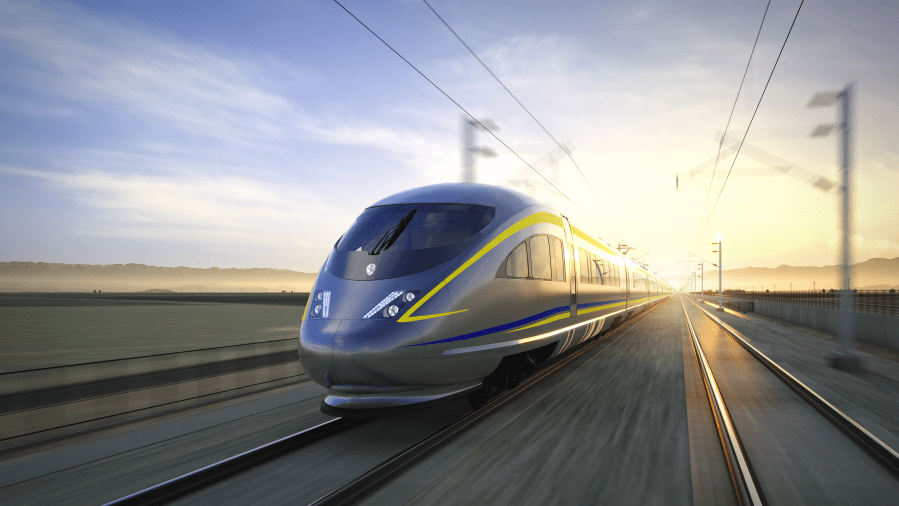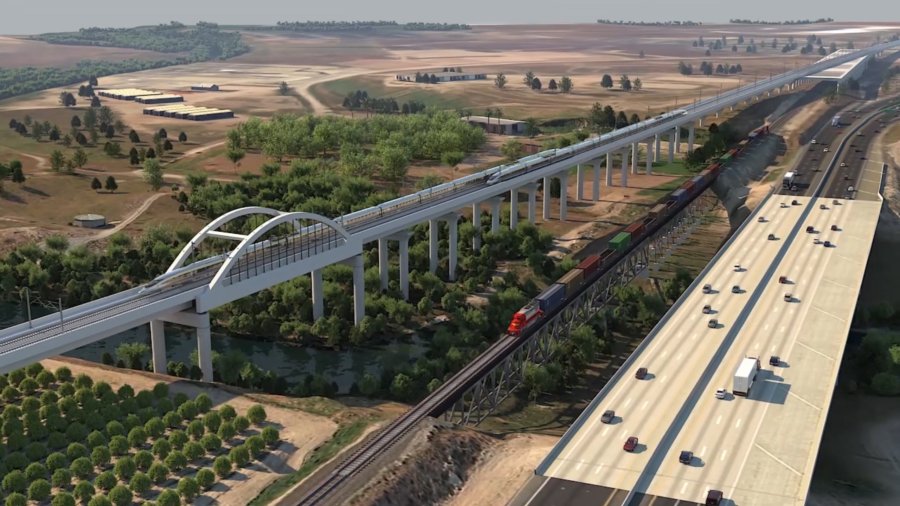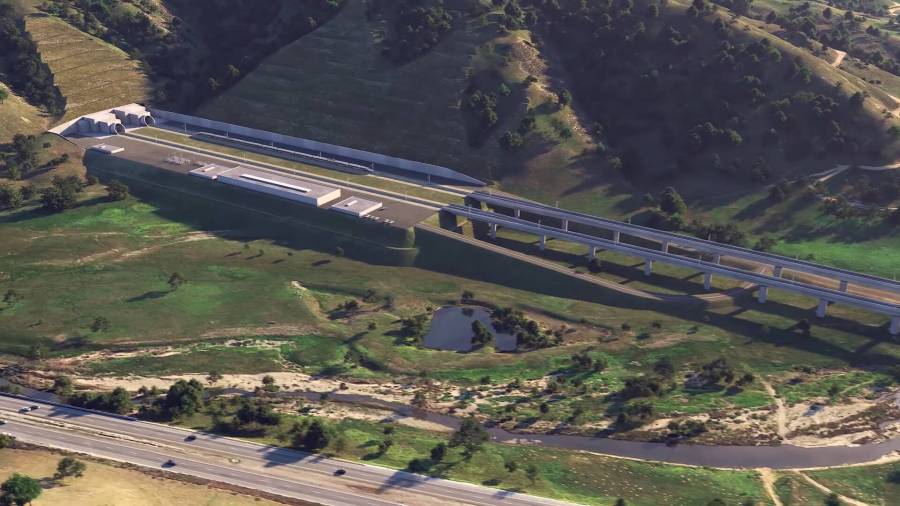California High-Speed Rail, the most ambitious public transportation project in the state’s history, is still miles away from being completed, despite decades of discussion and nearly ten years of construction.
Progress has kicked up in recent years as environmental hurdles were cleared, and the High-Speed Rail Authority hopes to have the Central Valley segment, which will connect Merced to Bakersfield, completed by 2030 (give or take).
But what would it take to get the entire project — Bay Area to Los Angeles — completed even sooner? Maybe as soon as 2028, in time for the Olympics?
That’s what industry experts and activists met to discuss Wednesday evening during an online forum hosted by Streetsblog, an urban planning news and information website that focuses on transit and public safety.

While it might sound like a pipe dream, those in attendance for Wednesday’s roundtable discussion argue it could be done, albeit with a massive amount of cooperation and significant buy-in from the federal government.
Roger Rudick, editor at Streetsblog San Francisco and the moderator for the panel, argued that there is a long history of major public projects being conceived, planned and completed within much smaller timeframes.
“In 1962, President Kennedy said, ‘We will go to the moon before the decade is out.’ Six years later, humans traveled to the moon, and a year after that they walked on the moon,” Rudick said in his opening remarks. “The Transcontinental Railroad was built in six years. And they started construction during the Civil War. I would say that’s a pretty big socio-economic challenge for starting a big project.”
Rudick added that China was able to complete 25,000 miles of rail in the last 15 years, so there is plenty of precedent for one of the world’s superpowers to build a comparatively minuscule amount of rail in a similar timeframe.
So what’s standing in the way?
Boris Lipkin is the Northern California Regional Director of the California High-Speed Rail Authority. Appointed to the position by former California Governor Jerry Brown, and re-appointed by Gov. Gavin Newsom, he oversees the project between San Francisco and Merced County.
Lipkin says there’s a lot to juggle with such a massive undertaking, including working with municipalities, utility companies and environmental requirements.
He says the Authority faces hundreds and sometimes thousands of different “veto points” during construction, including blackout windows for construction, third parties being affected by the construction, and even competition with Burlington Northern Santa Fe – the nation’s largest freight rail company – which has the ability to pause construction during some of the busiest shipping months.
“There’s permitting, and other things that all kind of add up to the narrowing of construction windows of when you can actually do work,” Lipkin said, adding that the Authority is also trying to build while maintaining California’s “values,” including protecting prior rights and endangered species.

He says almost all of the major environmental reviews have been completed, with the sole outlier being the segment between Palmdale and Burbank, and the Authority plans to have that completed by the end of the year.
In the meantime, construction is being done in the segments of the massive project that have already been approved. Meaningful progress has been made when dealing with the rail’s right-of-way and important infrastructure projects, including bridges and overpasses, have been completed throughout the Central Valley in preparation for the line’s eventual opening.
So the project is moving along, albeit at its own pace.
Major challenges are still on the horizon, including boring out tunnels for the rail, which, when completed, will be the longest rail tunnels in the U.S. The equipment needed for that crucial part of the rail system has a long lead time, Lipkin said.
But the Authority has also said that the enormous amount of work needed to get it done in an abbreviated window could be a bigger load than California’s various construction companies could handle.
“So we’re talking about some pretty big, big numbers,” Lipkin said. “It’s a question of, ‘Can that level of construction happen in that kind of timeframe?'”
Essentially, even if the project was fully funded, would there be enough labor to do it?
Carter Lavin, a transportation activist and political organizer, countered that that’s simply not a good enough reason to stick with the slower timeline.
“Labor shortages are a very common thing that happen across the board in every sector,” Lavin said. “There are people in other parts of the United States who would absolutely love to come to California and do the work.”

Ultimately, though, Lipkin says it’s not a matter of will standing in the way of an early completion point, but rather, a lack of funding – an issue that has plagued the project since its inception.
Both Lipkin and the transit advocates who gathered to discuss an accelerated timeline concluded that an early completion would require the federal government to step in and help cover a significant portion of the bill.
“Out of the funding that we have so far, about 85% of that has come from the State of California, and 15% has come from the federal government,” Lipkin said. “When we did the highway system over thirty, forty years of highway construction, those ratios were reversed. So the federal government was 80 to 90% and state governments supported it with about 10% of the needed funding.”
California is doing its best to cover the costs, and Lipkin believes the project can be completed with the state footing the majority of the bill, but if Californians want the High-Speed Rail completed sooner, the federal government would have to chip in significantly more.
In agreement, Lavin argued that California’s economy and taxes contribute so much to the federal government, and in response, Washington should make the project a priority, especially as the current administration stares down the barrel of a climate emergency.
“The number one source of carbon emissions in California is cars,” Lavin said. “So when we’re connecting tens of millions of people with high-speed rail, when we’re connecting the 6.5 million people who live in the Central Valley with a high-speed rail, this will offset so much, this will get so many cars off the road.”
Making rail a priority is a challenge that the Authority says starts with changing mindsets.
“The differences between us and Europe, or Asia in this regard, is that, in many ways, high-speed rail projects are sort of the largest projects that governments usually undertake,” Lipkin said. “And in other parts of the world, that becomes sort of these national priorities in a way that I don’t think we’ve penetrated yet.”
One reason that other nations prioritize rail – tradition.
“In many cases in Europe, certainly there is a deep tradition of passenger rail ridership,” said Eric Eidlin, Station Planning Manager for the City of San Jose and an educator at San Jose State University. “There was always this sense that, you know, riding the train is a really important way to connect places and to get around.”

Eidlin added that completion of the expansive project should be treated with more urgency due to the implications of a possible “climate apocalypse,” with record-breaking temperatures across the globe driven by climate change.
“This project will take a long time to build, so the payoff will be in the long-term, but I do think we do need to be thinking on that time horizon, you know, it’s not just about the greenhouse gas emissions in 5, 10 years, but in 30 years, and how are we setting ourselves up for the future long-term?”
In addition to any carbon-reducing benefits, Lavin urged those who were looking to become more informed about the High-Speed Rail project to think of it as more than just a transportation undertaking.
“I think most Californians can barely afford rent, I think most Californians are worried about putting food on the table, most Californians are struggling. And I think an important part is the high-speed rail is going to help them,” Lavin said. “When we talk about job access … having a hard time affording rent, frankly speaking, the high-speed rail project is, in a sense, one of California’s biggest bit of affordable housing infrastructures going on.”
He urged listeners and supporters of the project who want to see it be completed sooner to call their local representatives, Gov. Newsom’s office, and any of the candidates for the upcoming California Senate election and urge them to support the project and advocate for additional federal funding.
Lipkin said support for the High-Speed Rail project has only grown since it was first approved by voters in 2008. In a recent poll by UC Berkeley, support for the project was about 20 percentage points higher than the percentage of people who were against it.
“I think California is pretty united in wanting to see this project happen,” Lipkin said, acknowledging that questions remain about how fast it can be completed. “The support is there, and we were very lucky to have that, because there’s no way to move something like this forward without very, very strong support. And we certainly have that across the board.”
The longer the project takes to complete, the more expensive it will become, experts say, and whether or not the project has the support of everyone in the state, it’s officially reached the “point of no return,” Lipkin said.
The California High-Speed Rail is coming, if not in five years, then a few years later. It’s up to its supporters to make an accelerated timeline a reality.
To track the latest progress of California High-Speed Rail, click here.





















